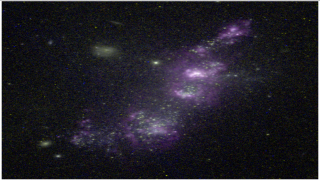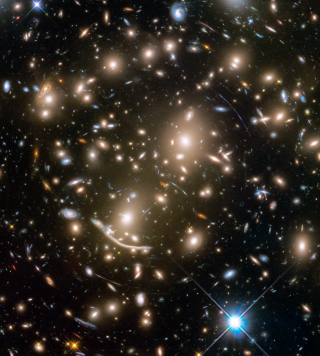Bibcode
Corsini, E. M.; Méndez-Abreu, J.; Pastorello, N.; Dalla Bontà, E.; Morelli, L.; Beifiori, A.; Pizzella, A.; Bertola, F.
Referencia bibliográfica
Monthly Notices of the Royal Astronomical Society: Letters, Volume 423, Issue 1, pp. L79-L83.
Fecha de publicación:
6
2012
Número de citas
34
Número de citas referidas
30
Descripción
The early-type spiral NGC 4698 is known to host a nuclear disc of gas
and stars which is rotating perpendicularly with respect to the galaxy
main disc. In addition, the bulge and main disc are characterized by a
remarkable geometrical decoupling. Indeed, they appear elongated
orthogonally to each other. In this work, the complex structure of the
galaxy is investigated by a detailed photometric decomposition of
optical and near-infrared images. The intrinsic shape of the bulge was
constrained from its apparent ellipticity, its twist angle with respect
to the major axis of the main disc and the inclination of the main disc.
The bulge is actually elongated perpendicular to the main disc and it is
equally likely to be triaxial or axisymmetric. The central surface
brightness, scalelength, inclination and position angle of the nuclear
disc were derived by assuming that it is infinitesimally thin and
exponential. Its size, orientation and location do not depend on the
observed passband. These findings support a scenario in which the
nuclear disc is the end result of the acquisition of external gas by the
pre-existing triaxial bulge on the principal plane perpendicular to its
shortest axis and perpendicular to the galaxy main disc. The subsequent
star formation either occurred homogeneously all over the extension of
the nuclear disc or through an inside-out process that ended more than 5
Gyr ago.
Proyectos relacionados

Grupo de Estudios de Formación Estelar GEFE
El proyecto interno GEFE está enmarcado en el proyecto coordinado, ESTALLIDOS, financiado por el plan nacional desde el año 2001. El ultimo proyecto aprobado es ESTALLIDOS 6.0 (AYA2016- 79724-C4-2-P). En el proyecto GEFE trabajamos en base al caso científico del proyecto ESTALLIDOS 6.0. Los estallidos de formación estelar (Starbursts o SB) son
Casiana
Muñoz Tuñón

Evolución de Galaxias en Cúmulos
Las estructuras en el Universo, a todas las escalas de masa, se han formado de una forma jerárquica y principalmente producidas por fusiones de galaxias. Sin embargo, esta formación jerárquica de las galaxias está modulada por el entorno en el cual se crean y evolucionan. Mientras que las galaxias de campo presentan una evolución pasiva, los
Jairo
Méndez Abreu